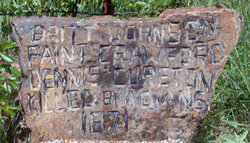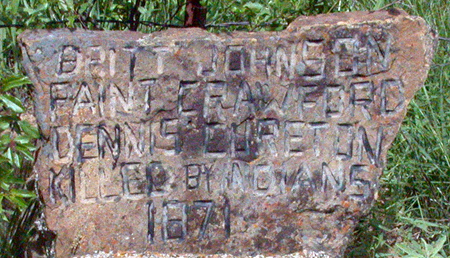This burial marker was placed at this location to remember the life and death of Paint Crawford. The exact location of his burial with his two companions is a closely guarded secret due to frequent activities of "treasure" seekers.
-----------------
Negro Britt Johnson and his colorful career, during the early days, always commanded the respect and esteem of those acquainted with his activities. Britt had been reared on the frontier among the white citizens, and although he was a negro in fact, in many respects, was not in ways.
During the latter part of January, 1871, J. B. Terrell, who still lives at Newcastle, was in Fort Worth and met Britt Johnson, who was there to try to sell his cattle to Dave Terrell. Negro Britt told Mr. J. B. Terrell that he was going to leave the following day, which was Sunday, for Fort Griffin. Britt, as a consequence, returned to Parker County, where he prepared to make his last journey.
Negro Britt was then living near old Veale Station. After loading his provisions in a bois-d'arc wagon, he started for Ft. Griffin, and was accompanied by Dennis Cureton, who was the slave of Wm. Cureton Sr. at the time of his death in 1859. Britt was also accompanied by Paint Crawford, who was a former slave of Simpson Crawford, one of the first settlers of Palo Pinto County. The three negroes had been living on the frontier for approximately fifteen years.
About the second night out, Negro Brit Johnson, Dennis Cureton, and Paint Crawford, camped at the Turtle Hole, at the head of Flint Creek, about nine miles north of Graham, and on the north side of the road. The next morning, Indians slipped over the hill from the east, and charged the three frontier colored men. According to reports, the Indians had previously told Negro Britt they would kill him if he were ever found out alone. Negro Britt's companions ran, but Britt stood his ground and sold his life as dearly as possible. All three were killed and seventy-two empty shells found around Negro Britt's body, told the story of his bitter fight. No doubt, he made several feathered savages bite the dirt. Britt and his companions were buried near where they were killed, and on the north side of the old Fort Worth-Fort Belknap military road.
And here in an unmarked grave, at the end of his long winding trail, that led to many ranches and cow camps in western Texas, and Indian villages in Oklahoma, lie buried the bones of Negro Britt Johnson. He was a faithful friend to the whites, was highly esteemed and respected by frontier citizens, and helped write much of the early history of Young and adjoining counties.
Note: Author personally interviewed: J. B. (Blue) Terrell, who conversed with Negro Britt in Fort Worth the day before he started on his last journey, and who passed Negro Britt's grave, about the second day after he was killed; Mann Johnson; Henry Williams; F. M. (Babe) Williams; F. M. Peveler; John Marlin; Uncle Pink Brooks; Jeff (Cureton) Eddleman, who was also a slave of Wm. Cureton, mentioned above; A. M. Lasater; Walker K. Baylor, son of General John Baylor; James Wood; and many others who lived in this section of the time.
The above story is from the book, The West Texas Frontier, by Joseph Carroll McConnell.
This burial marker was placed at this location to remember the life and death of Paint Crawford. The exact location of his burial with his two companions is a closely guarded secret due to frequent activities of "treasure" seekers.
-----------------
Negro Britt Johnson and his colorful career, during the early days, always commanded the respect and esteem of those acquainted with his activities. Britt had been reared on the frontier among the white citizens, and although he was a negro in fact, in many respects, was not in ways.
During the latter part of January, 1871, J. B. Terrell, who still lives at Newcastle, was in Fort Worth and met Britt Johnson, who was there to try to sell his cattle to Dave Terrell. Negro Britt told Mr. J. B. Terrell that he was going to leave the following day, which was Sunday, for Fort Griffin. Britt, as a consequence, returned to Parker County, where he prepared to make his last journey.
Negro Britt was then living near old Veale Station. After loading his provisions in a bois-d'arc wagon, he started for Ft. Griffin, and was accompanied by Dennis Cureton, who was the slave of Wm. Cureton Sr. at the time of his death in 1859. Britt was also accompanied by Paint Crawford, who was a former slave of Simpson Crawford, one of the first settlers of Palo Pinto County. The three negroes had been living on the frontier for approximately fifteen years.
About the second night out, Negro Brit Johnson, Dennis Cureton, and Paint Crawford, camped at the Turtle Hole, at the head of Flint Creek, about nine miles north of Graham, and on the north side of the road. The next morning, Indians slipped over the hill from the east, and charged the three frontier colored men. According to reports, the Indians had previously told Negro Britt they would kill him if he were ever found out alone. Negro Britt's companions ran, but Britt stood his ground and sold his life as dearly as possible. All three were killed and seventy-two empty shells found around Negro Britt's body, told the story of his bitter fight. No doubt, he made several feathered savages bite the dirt. Britt and his companions were buried near where they were killed, and on the north side of the old Fort Worth-Fort Belknap military road.
And here in an unmarked grave, at the end of his long winding trail, that led to many ranches and cow camps in western Texas, and Indian villages in Oklahoma, lie buried the bones of Negro Britt Johnson. He was a faithful friend to the whites, was highly esteemed and respected by frontier citizens, and helped write much of the early history of Young and adjoining counties.
Note: Author personally interviewed: J. B. (Blue) Terrell, who conversed with Negro Britt in Fort Worth the day before he started on his last journey, and who passed Negro Britt's grave, about the second day after he was killed; Mann Johnson; Henry Williams; F. M. (Babe) Williams; F. M. Peveler; John Marlin; Uncle Pink Brooks; Jeff (Cureton) Eddleman, who was also a slave of Wm. Cureton, mentioned above; A. M. Lasater; Walker K. Baylor, son of General John Baylor; James Wood; and many others who lived in this section of the time.
The above story is from the book, The West Texas Frontier, by Joseph Carroll McConnell.
Advertisement
Advertisement


